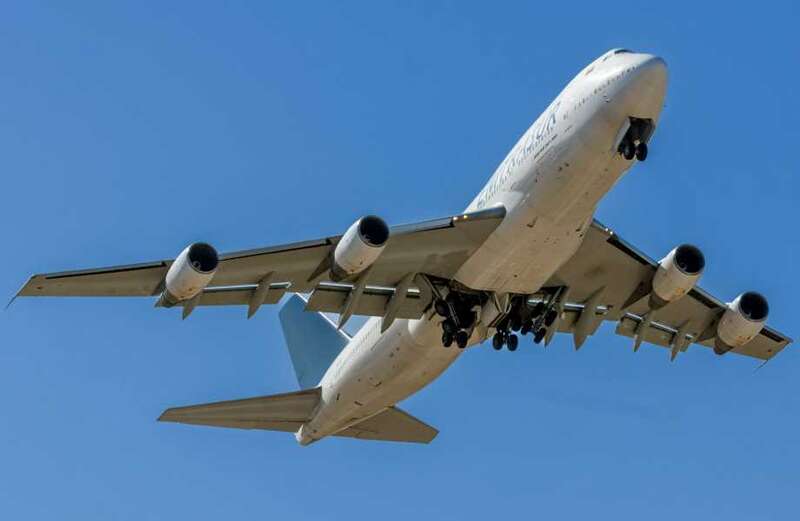TOP-secret documents revealed plans for an incredible Boeing 747 Air Carrier that could carry 10 fighter jets and 44 crew members.
The concept for the modified jumbo jets was created in 1973 and saw the airliner destined to be used for launching and recovering micro jets in mid-air.



The original Boeing 747 was released in 1968 - and became the world's first jumbo jet, 2.5 times bigger than any jet before it.
The mammoth plane was a huge leap in aviation milestones and completely shifted the way air travel was viewed.
Juan Trippe, the president of the airline Pan American Airways said just after putting in the order for the first 747-100’s, that the machine would be “a great weapon for peace, competing with intercontinental missiles for mankind’s destiny.”
 Andrew Tate 'tried to lure ex-Playboy model to Romanian lair' before his arrest
Andrew Tate 'tried to lure ex-Playboy model to Romanian lair' before his arrest
But just five years on from the launch, the US Air Force had other plans for the 747, focusing on the “great weapon” part of Trippe's comment.
They were considering turning innocent airliners into airborne aircraft carriers and commissioned Boeing to study the concept.
America already had a Navy Sea Carrier Force, enabling them to move airpower across the seas and to the coasts of several countries.
But the 747, alongside the newly introduced Lockheed C-5 was a new, modern kind of aircraft.
With their enormous power, size, and range, these planes offered a whole new spate of possibilities.
The Air Force made plans for the 747 to be converted into a mothership capable of carrying fighter jets to deep inland countries in just a few hours.
The new and improved 747 would have the capacity for 10 micro fighter jets, stored in a massive hangar and service bay in the belly of the plane.
This would mean the jets could be moved around the 747 with ease.
It would use an internal conveyor belt system to send out two fighters every 80 seconds, launching the entire “air wing” in 15 minutes.
Blueprints of the 747 showed two launch bays that each included a set of arms.
 Inside US's most remote town 2.4 miles from Russia where only 77 people live
Inside US's most remote town 2.4 miles from Russia where only 77 people live
After depressurising the bay, the arms would lower the fighter jet into the open air and release it.
The microjets would have also been able to be refuelled aboard the 747 via the two refuelling beams located at each bay.
And if the jets needed to be rearmed or repaired, the arms would simply winch them back aboard.
The carrier crew could turn around a micro-fighter for a new mission in as little as ten minutes.
Along with the 10 fighter jets, a crew of 44 personnel could also fit onto the 747.
This included 12 carrier crew, 14 fighter pilots, and 18 mission specialists.
Those onboard were planned to have space above what would have been the cockpit as a sleeping quarter and lounge area.
The Airborne Aircraft Carrier was a way to project air power quickly into a crisis zone.
Just 10 747s flown into a hot spot would bring with them a total of 100 combat-ready fighter jets.
But while the 747 Aircraft Carrier was on track to accomplish the idea, a series of problems surfaced that ultimately caused the plans to fail.
And the major problem lay with the micro fighters.
They would have to be a third of the weight of a normal fighter, with a wing span of five metres.
The plan was also to arm them with a pair of 20mm cannons and fit them with either air-to-air missiles, torpedos, or bombs.
This was one of the reasons why the USA Air Force dropped the concept, as well as the fact that air combat was evolving so dramatically throughout the 1960s and 1970s.
They were becoming faster, more reliable, and better at long-range missions.
So, developing a 747 carrier with special micro fighters would likely prove to be a dead end because, by the late 1980s, lightweight micro fighters would have been instantly outshined by fourth-generation fighters.
Air travel also wasn't nearly as safe as it is today, and there would invariably be accidents.
Every crash involving a fully loaded 747 would destroy up to 11 airplanes and kill 11 sets of pilots.
And, the conveyor belt, launch, and recovery system would have to be invented and fitted to the 747.
Despite the failures that killed the Boeing 747 Airborne Aircraft Carrier back in the 1970s, the dream still lives on.
The Pentagon’s Dynetics X-61 Gremlins project has been developing uncrewed aerial vehicles that can be released from a plane, since 2019.
The experimental unmanned drones are outfitted with sensors, jammers, and weapons to accomplish a specific mission and then be recovered in midair by a modified transport aircraft following its mission.
The small, turbine-powered drone is cheaper and much easier to develop than a crewed micro fighter.
It comes as Boeing's X-plane of the future with 171ft superwings could take to the skies in just five years.
A full-scale demonstrator is now in the works and will test fly in just five years at the Nasa Armstrong Flight Research Center.





































